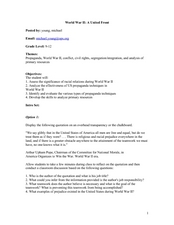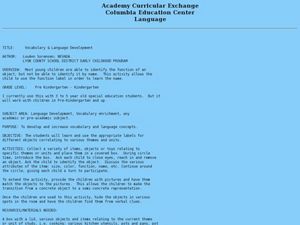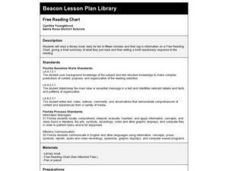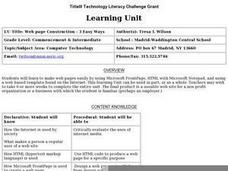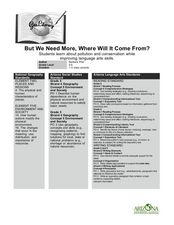Curated OER
World War II: A United Front
Students interpret historical evidence presented in primary resources. In this World War II lesson, students examine racial relations during the war and then examine propaganda techniques employed by the United States...
Curated OER
Paul Revere's Ride-Fact or Fiction?
Students discuss Paul Revere's ride. For this social studies lesson, students read Paul Revere's Ride and compare the differences between the poem and the historical event.
Curated OER
Owl Pellets
Students utilize owl pellets to explain part of the natural food chain, and the skeletal system. They construct a rodent skeleton from the skeletal parts foundin the pellet.
Curated OER
Digging Deeper in Mission San Saba
Seventh graders explain Spanish motives for establishing Mission San Sab?? and the reasons for the mission's failure. This lesson should be used when students already have an understanding of the Spanish mission-presidio system in Texas.
Curated OER
Children's Books
Students use their personal experiences to create students's books for younger students on topics to which they can relate. Students observe a guest speaker who talks about different formats of students's books that are available, then...
Curated OER
Solar System: The Four Inner Planets and Earth's Moon and Astronauts
Second graders read THe Magic School Bus: Lost in the Solar System. For this language arts and science lesson, 2nd graders explore the four inner planets. Students view the inner planets using Google Earth.
Curated OER
Movement
Students conduct an experiment. In this movement lesson, students see how far a marble will roll after coming down a ramp. The students change the height of the ramp to make it roll faster and record their results.
Curated OER
Vocabulary & Language Development
Students develop their vocabulary skills. In this vocabulary and language lesson, students practice naming everyday objects as they take part in 3 classroom activities that require them to note attributes of everyday objects their...
Curated OER
Ida Tarbell: Hysterical Woman vs. Historical Facts
Learners examine journalism and its different styles. In this effective communication instructional activity students create an editorial message and articulate an article.
Curated OER
You Can Find It!
Students locate different places including U.S. cities using longitude and latitude coordinates. In this longitude and latitude lesson plan, students locate 10 different locations.
Curated OER
Cultural Awareness/ Sharing Traditions
Students discuss topics relating to how their families celebrate holidays and observe certain religious customs. In this cultural awareness lesson plan, students work in groups to share their cultural traditions, the list similarities...
Curated OER
Free Reading Chart
Learners read library books daily for ten to fifteen minutes, log information on Free Reading Chart, giving a brief summary of what they just read, and write brief reactionary response to the reading.
Curated OER
Salmon Homing Instincts
Students role-play salmon returning to original streams using their sense of smell like the salmon do. They smell cinnamon, vanilla and peppermint on cards and follow that scent to locations in the classroom that represent their original...
Curated OER
Web Page Construction - 3 Easy Ways
Students create web pages by using Microsoft FrontPage and HTML with Microsoft Notepad, and use a web-based template found on the Internet to create web sites for non-profit organizations or businesses with which students are familiar.
Curated OER
"I Don't Pay Attention to Advertisements? (At least I don't think so?)"
Sixth graders study eight persuasive techniques that occur in a variety of media types. They write a persuasive essay and present it to the class. They create a "new product" for which they produce an advertisement using persuasive...
Project SMART
Exploring the History of Mathematics
Students research six different mathematicians using Internet resources. They examine the contributions of different cultures, women, and one that made a significant to geometry. They present their research to the class.
Curated OER
Famous People Research Project
Fourth graders research a famous person in Michigan history. They will use at least three different resources including technology to conduct their research. They then will use various forms of technology to create individual research...
Curated OER
Our Book Club
Students review a book considered to be their favorite for inclusion in a recommended books list. As a part of a book club, each student selected book will be included in a list of recommended books for a young adult's personal reading....
Curated OER
Workers in Factories During the Gilded Age
Seventh graders experience what life was like in the factories during the Gilded Age. They explore the reasons behind the move for work place reforms during the Progressive Era. Students discuss the factors that led to work place reforms.
Curated OER
Poetry
Fifth graders preview different poetry selections form different poets to narrow their criteria for a favorite poem. They use the web and written sources to find a favorite poem and then give an oral interpretation of their poem in class...
Curated OER
MAKING THREE DIMENSIONAL PLANT AND ANIMAL CELLS
Young scholars create two different cells, one plant and one animal. In this plant and animal cell lesson students form groups and construct a part of a cell. Young scholars then put them all together to form one plant or animal...
Curated OER
Is there a map in that story?
Eighth graders examine different pieces of literature from specific isolated Pacific islands. In this Geography lesson, 8th graders read and interpret a written selection. Students construct a map of the stories setting.
Curated OER
But We Need More, Where Will It Come From?
Students write a persuasive letter and create a poster about pollution and conservation. In this pollution and conservation lesson plan, students learn how humans are the number 1 cause of pollution.
Curated OER
TIMS, The Bouncing Ball: Math, Science, Measurement, Graphs, Variables
Students determine the exact relationship between the height from which a ball is dropped and the distance that it rebounds.
